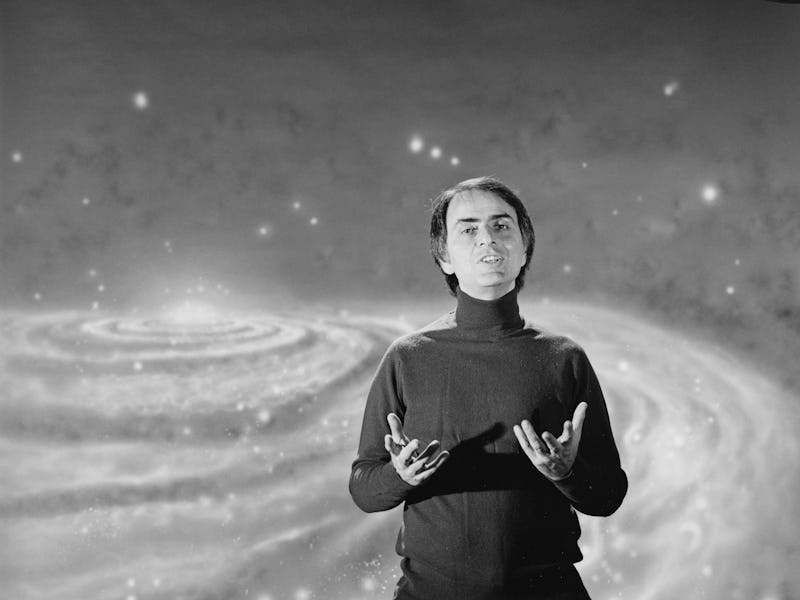What Carl Sagan’s ‘Star Wars’ video gets right about life in space
Would aliens really look like humans in a galaxy far, far away?

What do aliens and humans have in common? Probably not their looks.
This week we’re reminded of this via a viral 1978 clip of the late astronomer Carl Sagan. In it, Sagan discusses what Star Wars gets wrong about alien life. He calls out the popular franchise for its prejudice by mainly featuring white characters, and for assuming that aliens could even look like humans at all.
Life evolved on Earth through a series of fortunate events that all led to humanity taking its current shape. But life on Earth is unique: While aliens may be out there, experts say it is highly unlikely that another planet underwent the set of circumstances that led to us.
Here is what Sagan’s commentary got right about alien life in the cosmos, and why it is still relevant today.
What’s new — The clip features Sagan on The Tonight Show with Johnny Carson in 1978, nearly a year after the first Star Wars film was released. It went viral after it was tweeted by Zeus Tipado on Monday.
The 43-year-old footage was widely shared and by Tuesday, it was viewed over 2 million times. Online users praised Sagan for calling out the racism in the cast selection.
“It's extremely unlikely that there would be creatures as similar to us ...”
"The skin of all the humans in Star Wars, oddly enough, is sort of like this," Sagan says while holding out his own hands. "And not even the other colors represented on the Earth are present, much less greens and blues and purples and oranges.”
He also breaks down the inaccuracies of Star Wars, focusing on how the film misrepresents alien life.
"Star Wars starts out saying it's on some other galaxy, and then you see there's people,” Sagan says. "It's extremely unlikely that there would be creatures as similar to us as the dominant ones in Star Wars.”
Life on Earth is a result of various elements colliding, Sagan explains. Humans are part of a “unique evolutionary sequence,” and a result of “random events on the Earth,” Sagan says.
What are the ingredients for life on a planet?
While Earth formed 4.5 billion years ago from a swirling disc of gas and dust, the first signs of microbial life didn’t appear until 3.5 billion years ago. Our planet possessed the right chemical ingredients for life to develop, including carbon and water.
Its distance from the Sun means that Earth is also just at the right distance from the star to sustain liquid water on its surface — while still being far enough to stay protected from solar radiation (which is also due to the planet’s magnetic field).
Aliens that don’t look like white humans “don’t seem to be in charge of the galaxy,” Sagan reflects.
Earth is also slightly tilted on its axis, which gives humans seasonal changes and prevents any extreme temperatures from taking place.
Life developed through a set of evolutionary phases. Sets of organisms developed various ways of exploiting energy sources, resulting in diverse and complex creatures.
For example, Cyanobacteria, which is similar to algae, are the first known lifeforms to develop photosynthesis, using energy from the Sun to produce oxygen. This led to Earth’s Great Oxidation Event, increasing the levels of oxygen on our planet, which led to the development of different, more complex lifeforms.
“Most evolutionary biologists would agree that if you started the Earth out again and just let those random factors operate, you might wind up with beings that are as smart as us, as ethical and artistic and all the rest,” Sagan says to Johnny Carson. “But they would not be human beings.”
What will aliens look like?
Efforts are currently underway to find life beyond Earth. But for now, experts can only theorize what extraterrestrials will look like.
Its possible life elsewhere will similar to Earthling in some ways. Zoologist Arik Kershenbaum, author of The Zoologist’s Guide to the Galaxy, previously told Inverse life on other planets would check off these boxes:
- They would be symmetrical: The left side of their bodies would look like the right
- They would have the ability to move
- They would be able to reproduce, at least through cell division
NASA also studies microbial life, like those within sulfur deposits and fungi, in an effort to understand how microbial life could exist elsewhere. For example, it’s possible ancient, sulfur-metabolizing microbes once existed on Mars — the Perseverance rover is tasked with finding signs of possible form of life.
However, while it’s very likely some form of life exists out there in the universe, it’s unlikely this life looks like Luke or Leia.
Did Carl Sagan believe in aliens?
The famous astrobiologist was a proponent of alien life. He believed the best way to determine their existence was through observation of the universe and attempts to contact them.
Sagan supported a number of SETI (Search for ExtraTerrestrial Intelligence) projects, a series of interrelated programs that look for intelligent life by trying to detect radio signals from other planets.
During a 1977 lecture at the Royal Institution in London, Sagan presented a message to aliens in binary code, arguing that alien intelligent life could use a language like this to communicate.
“Wouldn’t it be lovely,” Sagan says, “to make contact with another civilization that has arisen and evolved independently?”
This article was originally published on